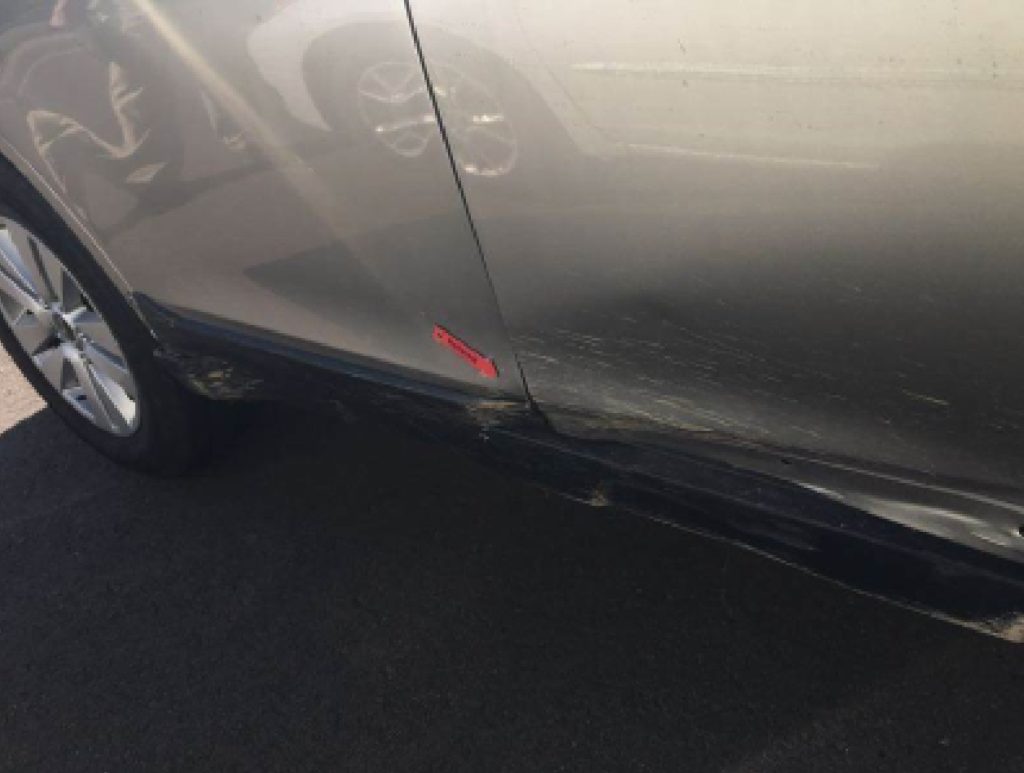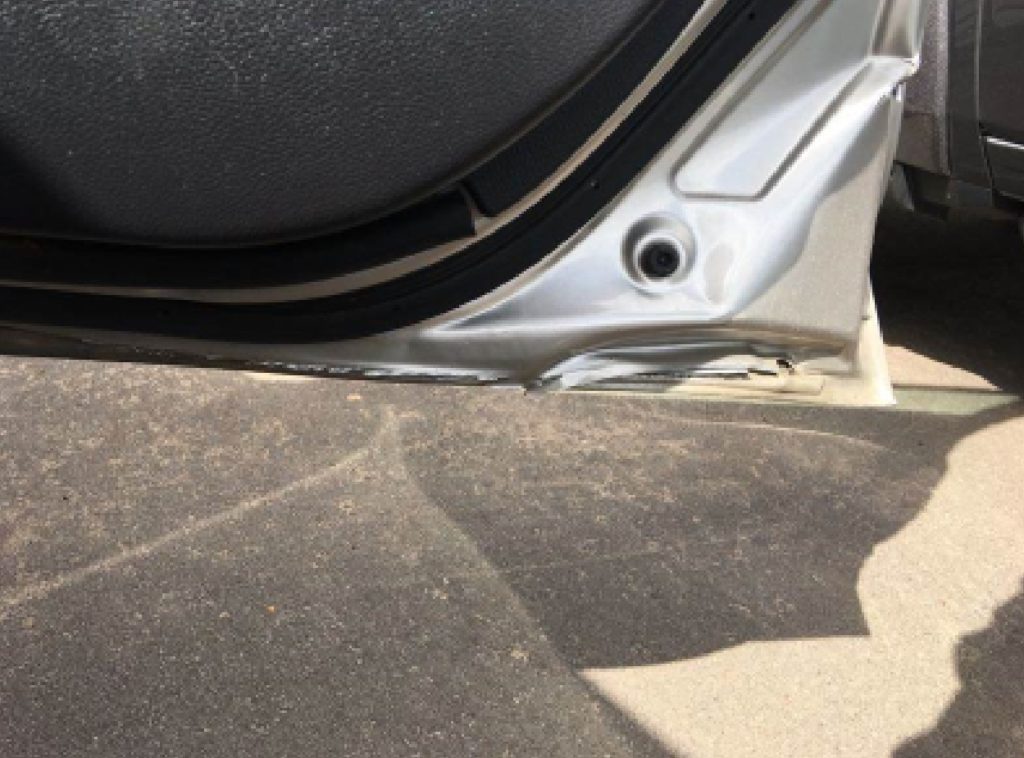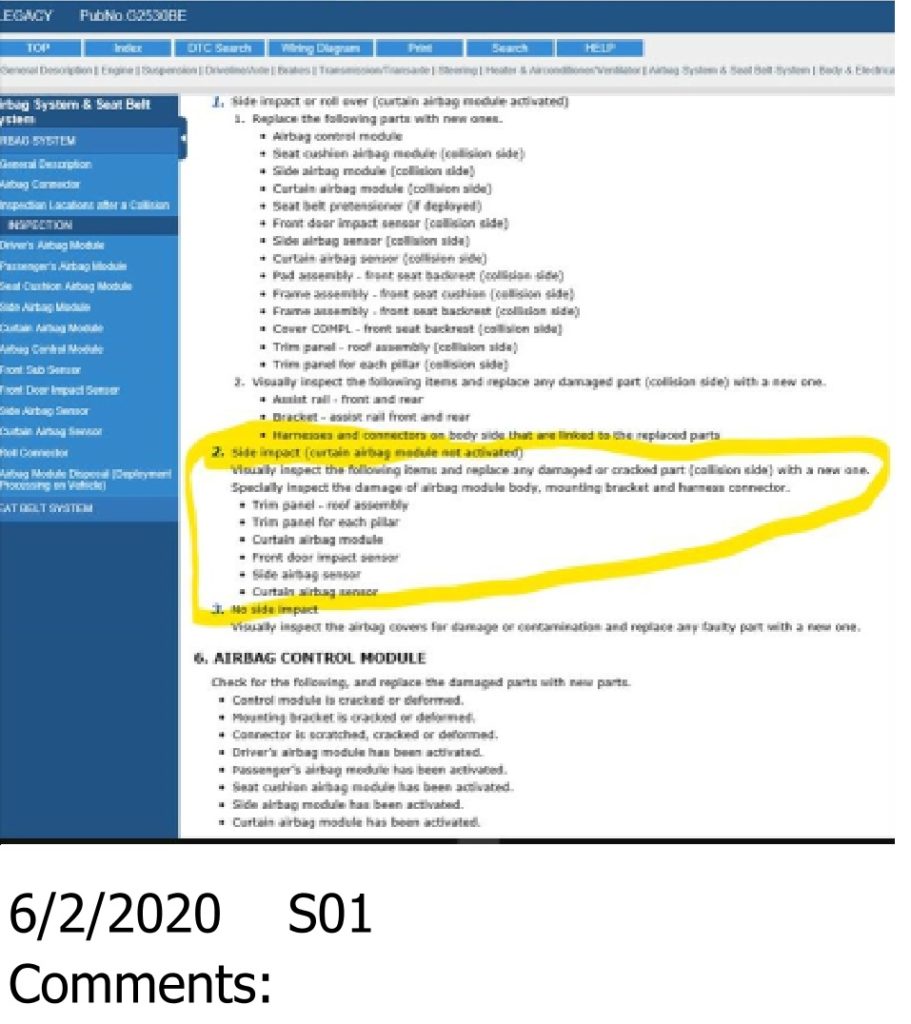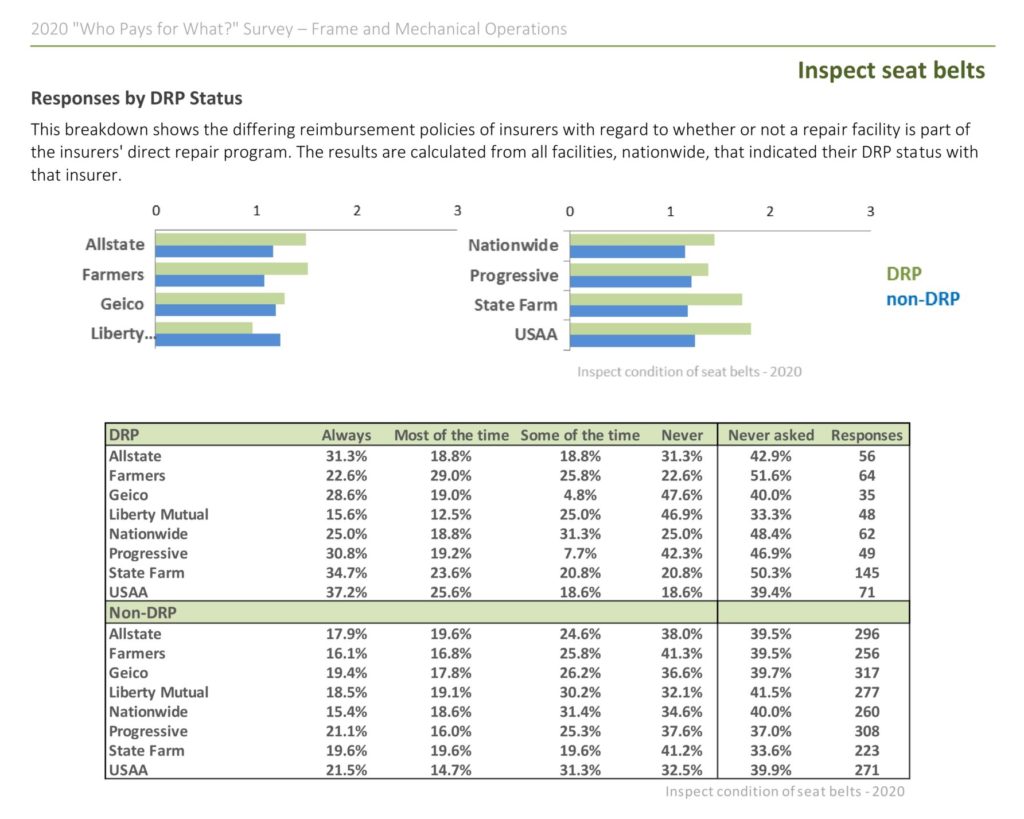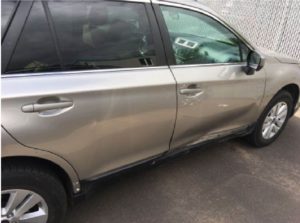
Shops report State Farm refusals of Subaru, Honda auto safety system inspections
By onBusiness Practices | Legal | Market Trends | Repair Operations | Technology
Three repairers in separate states this summer reported State Farm refusing to reimburse OEM-mandated safety inspections following a repair.
In Wisconsin, a body shop provided State Farm with additional clarification from a Subaru representative, only to still be rejected.
A Tennessee repairer says the insurer used to pay for the Subaru post-collision inspections while he was part of the Select Service program. After State Farm dropped him from the direct repair program network, they ceased to do so, he said. He has since been vindicated in appraisal clause proceedings for a Virginia customer.
In Missouri, a shop who had previously seen State Farm approving General Motors safety inspections found their customer denied reimbursement for a Honda examination — on the disputed grounds that no one else in the area charged for the procedure.
Such refusals place a repairer in a tough place, for failure to perform such inspections can be easy grounds for a lawsuit over a subsequent crash. For example, former shop owner Aaron Clark shared a harrowing example of such litigation during the 2017 SCRS OEM Collision Repair Technology Summit; the complaint hinged on uninspected airbags which failed to deploy during a separate accident.
It might be particularly egregious for State Farm to continue to refuse reimbursing customers for the Subaru operations. As noted above, Subaru has confirmed it has spoken directly to State Farm about the inspections, and the appraisal clause process has already proved the insurer wrong once.
Contacted for comment about all three alleged incidents, State Farm said for each it had “nothing to share.”
Wisconsin: Subaru can’t sway carrier
Luke Salter, production manager at Eau Claire, Wis.-based Trubilt Collision Center, described a 2017 Subaru Outback Premium “hit pretty hard in the door” — to the point the shell itself needed to be replaced.
Subaru can require many inspections to be performed following any collision, a term it officially defined this spring as “damage that exceeds minor outer body panel cosmetic distortion.”
But State Farm refused to cover those inspections on the Outback.
Trubilt is certified by Subaru, and Salter forwarded State Farm further explanation solicited from a Subaru representative.
“It scares me, and I’m sure it scares many of the OEM’s, when any insurance company says ‘nobody else is doing these operations’,” Salter wrote to State Farm estimatics team manager Mike Cahalan on July 10. “When an insurance company underwrites a policy for any particular vehicle, you as an insurance company should know what the proper repair procedures are and that should be reflected in their premiums.
“From our stand point, as soon as that vehicle leaves the door our company is held liable for the repairs not the insurance company. That’s why we focus on a safe and proper repair. Every time. The OEM’s create body repair manuals based off what the engineers determine is required to properly put that vehicle back on the road safely. These are vehicle specific based of the VIN and not generic across their vehicle lines.
‘In many of our conversations you mentioned that your Crash Team routinely works with all the OEM’s regarding this issue. You have mentioned several times that they say it is not needed. From the information below, directly from Subaru (who is copied on this email), they have stated that the insurance companies are aware of the post collision inspections and it sounds likes there has been recent conversations regarding it.
“What concerns us is why are you allowing shops to repair vehicles improperly, knowing that you are provided and have this information from the factory and turning a blind eye when shops ask for it?”
But Trubilt still found the insurer resistant. The shop ultimately performed the inspections itself and ate the cost, Salter said.
The shop wasn’t permitted to share the specific Subaru response due to the OEM network’s policies. However, Subaru was willing to give us additional perspective on its post-collision safety inspection mandate.
Subaru collision certification manager Devin Wilcox wrote in a Sept. 9 email:
Subaru is committed to the safety of our customers and to engineering vehicles that are amongst the safest in the industry. Subaru’s dedication to safety is further exemplified by our processes for vehicle repair and inspection. These processes are well known in the industry and published to STIS (Subaru Technical Information Systems) in reference to the post collision inspections we require and why they need to be completed. Furthermore;
– The comment that ‘others aren’t doing it’ is immaterial; Subaru requires these tasks after a collision, and they must be performed to ensure that the safety and longevity of the vehicles is returned to pre-collision condition.
– Subaru defines a collision as damage that exceeds minor outer body panel cosmetic distortion (as identified in the pre / post scan position statement).
– Regardless of the location of a collision or airbag deployment, STIS identifies the model and model year specific inspection procedures to be performed based on that location.
– Subaru engineers developed the repair and inspection procedures and requires the Subaru Collision Network to follow them. (Minor formatting edits.)
Wilcox also confirmed Sept. 9 “we have previously spoken with State Farm in regards to this matter.”
Missouri: Is everyone working for free?
Honda OEM repair procedures list instructions for inspecting a vehicle when airbags do — and don’t — deploy.
“After a collision where the airbags or the side airbags do not deploy, inspect for any damage or any deformation on the SRS unit, the front impact sensors, and the side impact sensors. If there is any damage, replace the SRS unit and/or the sensors,” Honda wrote. “Replace all damaged parts.”
Asked to elaborate on that mandate to inspect vehicles where the airbags didn’t deploy, a representative from American Honda wrote Oct. 13:
SRS safety inspections have been a part of manufacturer service information for many years. Very little information in this document is new. Honda engineers have required inspections and calibrations for SRS, seat weight sensors, seat belts and many other systems after a collision for decades. Today’s vehicles are designed to absorb and direct collision energy. Many times the delta V or change in velocity may not be enough to deploy an air bag but the forces of inertia on the vehicle can damage sensitive equipment like sensors and modules. If this equipment or their mounting locations are disturbed, they may no longer function properly in a subsequent collision. That’s why a physical inspection is necessary.
We asked if Honda had discussed such inspections directly with State Farm.
“American Honda and State Farm have a good working relationship and open lines of communication,” the American Honda representative replied. “Honda’s role is to inform the industry of the proper way to safely repair our vehicles. What each shop or insurer does with this information is not within our control.”
Learn more about required Subaru inspections at virtual Repairer Driven Education
Trying to educate your staff, local insurers, and your customers on the need for Subaru inspections following a crash? Don’t miss ‘Required Repair Procedures and the “Why?” Behind Detailed Inspections’ during the virtual SCRS OEM Collision Repair Technology Summit Nov. 2-6. Subaru collision certification manager Devin Wilcox “will speak to the required quality repair procedures and why such detailed inspections are needed post-collision as well as the need for pre and post scanning,” according to a course description. “This presentation will be focused on the ‘why’ Subaru’s repair procedures are published in such detail.” The session and other OEM Summit segments featuring Audi, Ford, General Motors and DuckerFrontier will be released online at 10 a.m. ET on Nov. 5 and be available for replay through Aug. 31, 2021 — which means you could pull the Subaru video out for backup during a disputed repair. Registration is $150, or pay $375 for the full series pass, which grants access to the virtual OEM Summit and more than a dozen $75 virtual Repairer Driven Education courses, all replayable as well.
Saint Louis, Mo.-based Hunter Auto Body general manager Kyle Motzkus shared a July recording of State Farm refusing to pay for that work on a 2013 Honda Civic EX. The damage involved was significant enough to warrant a fender replacement.
To State Farm’s credit, the insurer’s representative doesn’t dispute the need for the inspections in the call. However, he insists no one else is charging for it.
The State Farm representative starts to state that everyone in Hunter’s market is doing the work, then corrects himself to state that “people are performing” the inspections for free. He says this means it is “unreasonable for you to expect me to pay” for that work.
Motzkus says he had been told by another State Farm representative that the insurer pays for OEM procedures.
“Here we have an OEM procedure,” Motzkus says. He asks the State Farm rep if he’s saying “every shop in this area does these inspections, and they don’t charge you for them.”
“I cannot say that I know the processes of every shop in the entire market,” the State Farm rep says, calling it “complete speculation” to make a “categorical statement” like that. But he agrees that the majority of the market is — “to my knowledge, yes.”
Motzkus called it “100 percent fact” that this was incorrect, listing shops he described as at one point outright unaware of the inspection process. “I could go on and on and on,” he said.
The State Farm rep says “I don’t have knowledge of those shops” inspecting or not inspecting, to which Motzkus points out that all the facilities are in the market area.
It was “my understanding that that is the case,” the rep says. Motzkus argues that “it’s not an understanding,” since the rep has backtracked on the comment about the market.
“You yourself have paid me for these inspections” on four claims, Motzkus said, describing the insurer and shop reaching agreement on a Chevrolet Cruze and Camaro. (General Motors has a list of post-collision inspection requirements as well.)
“Now you’re gonna tell me that you don’t owe for it,” Motzkus says.
“I was mistaken,” the State Farm rep said. He said he had received new information “that changed how I am going to write an estimate.”
Motzkus argues, “This is gonna look really bad. … You need to do the right thing here.”
“It’s unreasonable for us to have to pay for operations that other shops are performing at no charge,” State Farm’s rep says.
In a recent interview, Motzkus said he’s spoken to seven shops in the market. Either they had “no clue” about the operation he was describing, or they charge State Farm for such work, he said.
Asked if State Farm ultimately ended reimbursing the inspections, he said: “Of course they didn’t pay it.” The shop ultimately ate the cost of the work, he said.
Tennessee: Change alleged after DRP departure
Bristol, Tenn.-based Wallace Collision Center continuous improvement engineer John Russell Baker said State Farm repeatedly paid his shop for Subaru safety inspections while he was on its Select Service program.
But after the Subaru-certified repairer had been removed from the DRP earlier this year, State Farm refused to cover a 2016 Subaru Forester 2.5i Premium the shop examined July 6.
The vehicle was hit hard enough that it needed a new rear bumper cover and repairs to the rear body panel and floor pan.
Ultimately, Wallace was proven right during the appraisal clause proceedings, with a final estimate dated Sept. 15 that included hours of inspections and associated R&Is.
“Who Pays for What?” data collected from July 1 to early August shows State Farm agreeing to reimburse customers of both DRP and non-DRP shops who bill for safety inspection work related to seat belts. But the insurer’s consistency in paying drops if claimants use non-DRP shops.
In August, Wallace Collision discussed with State Farm a 2018 Subaru WRX hit hard enough to need a new door intrusion beam.
“They just refused to pay,” Baker said. As it was a third-party claim — State Farm insured the at-fault party — the customer had no appraisal clause recourse. Wallace Collision ultimately did the procedures “at our cost,” which Baker remarked was not a sound financial policy.
He said the shop didn’t discuss the matter with the carrier following the appraisal clause win in September.
State Farm also has more recently refused inspections on a 2020 Subaru Ascent with “heavy front-end damage,” Baker said. The vehicle came to the shop Sept. 14, the day before the appraisal clause victory in the Forester repair. Baker said he hadn’t brought up the appraisal win in that case either.
That owner’s Tennessee State Farm policy lacked an appraisal clause except for total losses, according to Baker. “That didn’t turn out too good,” he said.
That recourse is gone, and the customer doesn’t want to pay out-of-pocket for inspections, according to Baker. He said the shop will have to resort to requiring a hold-harmless agreement be signed by the motorist.
More information:
Images:
State Farm refused to cover safety inspections on this 2017 Subaru Outback Premium ultimately repaired at Trubilt Collision Center. (Provided by Trubilt)
State Farm refused to cover safety inspections on this 2017 Subaru Outback Premium ultimately repaired at Trubilt Collision Center. Door damage is shown here. (Provided by Trubilt)
State Farm refused to cover safety inspections on a 2017 Subaru Outback Premium repaired at Trubilt Collision Center. (Subaru procedures; provided by Trubilt)
Some insurers less consistently reimburse charges for inspecting seat belts from repairers not on their DRP, according to summer 2020 “Who Pays for What?” polling. (Provided by CRASH Network and Collision Advice)

